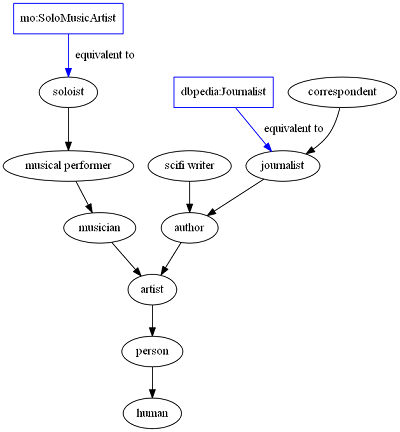I am proud to announce the immediate release of UMBEL version 1.50. This is a major effort that took a year to release.
What is UMBEL?
Let’s start by explaining what is UMBEL for the ones that never encountered this project before. UMBEL stands for “Upper Mapping and Binding Exchange Layer“. It is a conceptual structure that is designed to help content interoperate between systems.
UMBEL is a coherent general structure of 34 000 reference concepts which provides a scaffolding to link and interoperate other datasets and domain vocabularies. The conceptual structure is organized in a structure of 31 mostly disjoint SuperType.
What are UMBEL’s Objectives?
UMBEL’s main goals are:
- To create a scaffolding for defining knowledge graphs
- To create a rich semantic to identify and help disambiguating entities
- To help expend queries to semantic search engines
- To help inter-linking ontologies to create a coherent ontological environment
- To help structure and federate information silos
What is new in UMBEL version 1.50?
Many things changed in UMBEL 1.50: additional of new concepts, multiple structural fixes and improvements, etc. However there are 3 major changes that occurred in this release:
- Complete update and addition of linkages between UMBEL reference concepts and related classes existing in external ontologies
- Removal of all the named individuals from UMBEL. UMBEL is now only composed of classes reference concepts
- Reshaping of the
SuperTypeupper structure by adding new ones and removing some of them
For the complete list of UMBEL changes, I would strongly suggest you to read Mike’s blog post about this UMBEL release.
UMBEL Mapping to External Ontologies
One interesting aspect of the UMBEL structure is to use the coherent structure to federate information silos. We can do that by linking ontologies and vocabularies, used to describe entities indexed in these silos, directly into UMBEL.
But what does that mean? Let’s take a look at a portion of the UMBEL structure related to actors, authors and their relations to humans:

Now let’s assumes that we have two data sources:
- DBpedia from which we want to use its Journalist entities, and
- Musicbrainz from which we want to use its solo musical artist entities
The journalist entities of the DBpedia data source belong to the dbpedia:Journalist class of the DBpedia ontology. The Musicbrainz solo musical artists belong to the mo:SoloMusicArtist class of the Music Ontology. If you check each of these ontology, you won’t find any connections between these two classes. They appears to be living in two different [conceptual] worlds.
However, what happens if these two classes get connected to some UMBEL reference concepts? Let’s take a look:

What we did here is to connect the two classes to the UMBEL reference structure using the equivalent to property. What we are stating with these assertions is that these two classes are equivalent to these other classes in UMBEL. This seems harmless, but when we start thinking about that, something special is happening.
The special thing that is happening is that we can now query the different datasets (Musicbrains and DBpedia) on new ground. We can now query them such that if I request to get the list of all humans, then I can and I will get all soloist and all journalist. If the data store to get all authors, then I would get all DBpedia journalists and maybe authors of other datasets that may be linked to the UMBEL reference structure.
This is an illustration of how UMBEL can be used to federate information silos.
The good news is that the UMBEL reference structure is already linked to 20 ontologies used by different organizations to define their data sources:
- DBPedia Ontology – Links between the DBpedia Ontology classes and the UMBEL Reference Concepts. Half of them comes from the linkage between Proton and UMBEL, and half the others come from hand mapping
- Geonames – Geonames
- Opencyc – OpenCyc Ontology
- Schema.org – Schema.org ontology defines entities known by Google and other search engines
- Wikipedia – Links between the Wikipedia pages and the UMBEL Reference Concepts
- DOAP – DOAP(Description of a Project) is a vocabulary for project description.
- ORG – The ORG (Core Organization) Ontology is a vocabulary for describing organizational structures for a broad variety of types of organization
- OO – OO(Open Organizations) is a vocabulary providing supplementary terms for organizations that wish to publish open data about themselves
- TRANSIT – TRANSIT(Transit) is a vocabulary for describing transit systems and routes
- TIME – The TIME(Time Ontology) defines temporal entities
- BIBO – BIBO (Bibliographic Ontology)
- CC – CC (CreativeCommons Ontology)
- Event – Event Ontology
- FOAF – FOAF (Friend Of A Friend Ontology) used to describe people and organizations
- GEO – WSG84 Geographic Ontology
- MO – MO (Music Ontology)
- PO – PO (Programmes Ontology)
- RSS – RSS (Really Simple Syndication Ontology)
- SIOC – SIOC (Semantically-Interlinked Online Communities Ontology)
- FRBR – FRBR (Functional Requirements for Bibliographic Records)
According to Linked Open Vocabularies (LOV) service, the UMBEL reference structure, along with these 20 ontologies linkage would enable you to reach 504 datasets tracked by LOV.